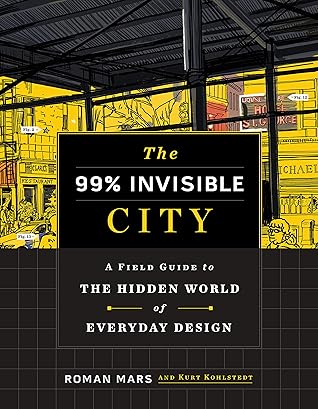More on this book
Community
Kindle Notes & Highlights
by
Roman Mars
Read between
February 23 - March 8, 2021
These initial photo shoots were fully clothed affairs. After some success, Munson was introduced to the famous sculptor Isidore Konti. He, too, was interested in hiring Munson for his work, but for this endeavor she would have to pose “in the altogether,” meaning naked. She and her mother agreed.
The Civil War’s unprecedented death toll also helped inspire another great innovation of the US Postal Service: home delivery. It was too painful and personal for mothers and wives to receive news of the death of a loved one in public post offices, so mail carriers started delivering letters directly to families so they could read the bad news in the privacy of their own homes.
Long dividing lines, wide lanes, and clear vistas help reinforce the illusion that drivers are traveling at a reasonable pace along a highway, even if that velocity is incredibly high compared to the speeds at which humans historically moved through the world.
All of this points to a larger traffic engineering issue: people tend to use what’s given to them. Presented with wide open spaces, drivers will go faster. Intentionally closing off space by adding trees and other landscaping along the side of the road may make a driver a little more anxious but also more cautious, which can in turn make roadways that much safer for everyone.
In 1783, Paris implemented a twenty-meter (roughly sixty-five feet) restriction on building heights, but with it came a crucial caveat: this limit was based on measuring up to the cornice line, not the roof zone above. Historically, Parisian buildings were tall, narrow, and deep, and typically featured a shop on the ground floor, a shopkeeper’s residence above that, and family residences above that. The top floor was often used for storage, but population pressures made that real estate too valuable. Property owners seeking to optimize their habitable space responded by building mansard-type
...more
Otis was working with a crew lifting and installing machinery at a furniture factory in the early 1800s when a rope snapped and sent a two-story service elevator platform crashing down. Having witnessed the impact of this failure firsthand, he developed a braking system for the company and earned himself a promotion.
Bridgewater Place in Leeds, sometimes called the Dalek, has faced even more serious wind-related issues. Due to its shape, prevailing winds hitting the tower were channeled down its side, which resulted in ground-level wind speeds of up to eighty miles per hour. In 2011, a truck was lifted and flipped over by these winds, tragically crushing a pedestrian in the process. People walking down the sidewalk have been knocked down and injured as well.
A building nicknamed the Walkie-Talkie Tower at 20 Fenchurch Street in London has also had issues with wind, but it was the tower’s relationship with the sun that has earned it other nicknames like the Walkie-Scorchie and the Fryscraper. During construction, it was discovered that the building’s concave facade could reflect and channel sunlight, raising temperatures on the streets below. The skyscraper managed to melt the plastic components of a parked vehicle, and it even lit a rug on fire in a neighboring building. One reporter demonstrated its power by frying an egg on the street below in
...more
This left open questions, however, about how to rebuild a Chinatown from scratch. A local businessman named Look Tin Eli hired architect T. Paterson Ross and engineer A. W. Burgren to design some new structures for the Chinese community even though neither man had been to China. They instead relied on centuries-old images, primarily of religious vernacular, to develop a new look for the new Chinatown. The resulting architectural collages were drawn from various Chinese traditions as well as questionable American ideas of what China looked like. Their approach was picked up by others in the
...more
But for centuries, the reddish-brown remnants of the Colosseum were also covered in another color: green. Until quite recently, there were trees, grasses, vines, and shrubs growing over what remained of the building and thriving in the varied microclimates of the structure, which range from damp and cool (in the shade on lower levels) to dry and hot (on the more exposed upper floors). This lush greenery inspired a number of historical artists and authors who visited Rome to write about their experience.
Impressed by the sheer variety of species inhabiting the ruins in the 1850s, a British botanist named Richard Deakin decided to do a botanical survey of this unique environment. He cataloged more than four hundred different species, some of which were quite rare (or completely absent, as far as he knew), in the rest of Europe. Puzzling over how these diverse plants could all wind up in one place, Deakin formulated a theory: the burrs and other seeds of these rare plants might have been carried in the fur and stomachs of the lions, giraffes, and other exotic foreign species that had been
...more
Located alongside the Pacific Ocean near the Golden Gate Bridge, the ruins of the Sutro Baths abut a seawall. There’s a cave nearby as well as the remains of some old bathhouses. At first glance, these may look like some strange, ancient, long-lost Roman ruins, but this swimming pool and amusement park complex was constructed only slightly more than a century ago. The endeavor was a pet project of German engineer Adolph Sutro, who struck it rich in the mining industry. Like a West Coast version of John D. Rockefeller, Sutro poured a lot of money into San Francisco, including this elaborate
...more
Trains, however, collapsed both space and time, often carrying passengers through multiple time zones in mere hours.
Standardized time ultimately became a defining characteristic of industrialization that put workers “on the clock” and ushered in an era of obsession with systematization and speed.


